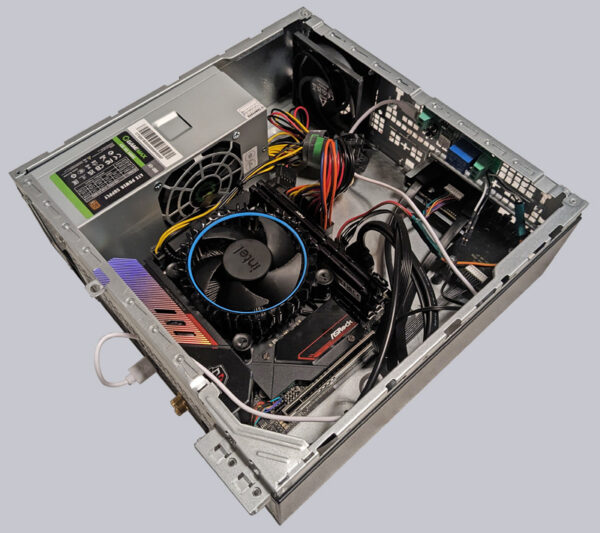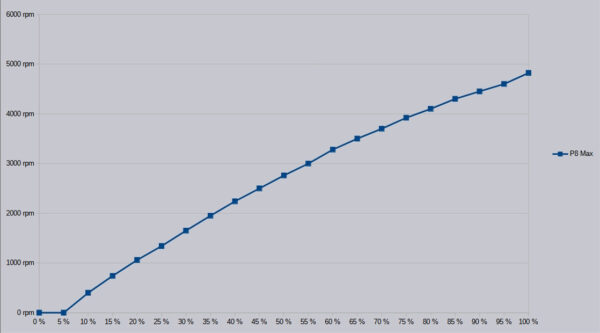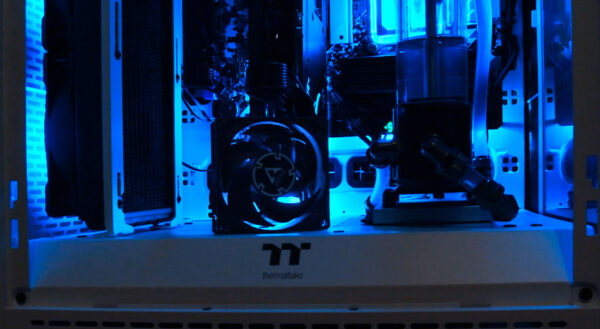
Test setup and results …
Before we get to the bare figures, let’s first take a look at the components used to make the P8 Max rotate.
The test system for measuring and checking the speed and volume consisted of the following components:
| Motherboard | ASRock B660 Steel Legend |
| SSD | Samsung Evo 750 250GB |
| CPU | Intel Core i7-12700K |
| RAM | 2x 8GB DDR4 Crucial Ballistix MAX 4400 |
| PSU | Antec HCG 750W Bronze |
| Graphics card | PowerColor Red Devil RX 6750 XT Graphics card |
| Case | Thermaltake The Tower 500 |
| Cooler | Custom water cooling |
| Operating system | Linux Mint 21.2 |
In order to evaluate the volume in a practical context, we then installed the P8 Max in an HTPC with Intel Core i3-12100 and ASRock Z790 PG-ITX/TB4.

PWM Regulation …
As already announced on the packaging, the P8 Max fans have a 0dB mode, which means that the fans stand still at a PWM setting below 5% and therefore work or rest silently.
We were able to reproduce the feature on our ASRock B660 Steel Legend without any problems. It is interesting to note that our sample only starts turning at 10% in PWM mode. Here it runs constantly at a good 410 rpm. If you then turn the fan speed down, we were able to measure a minimum speed of 200 rpm (which corresponds to 7%). The P8 Max was also able to run at 6%, although the speed could no longer be read out. It should also be noted here that the P8 Max operates evenly in all ranges and there are hardly any measurable speed fluctuations. Under full load, we were able to measure a good 4838 rpm free-standing. Although this does not quite correspond to the specified 5000 rpm, it is within the tolerance range.
Before we check off the topic of PWM control, we sent the P8 Max to the performance test bench again. As we can see here, the P8 Max works like Swiss clockwork. The speed adapts almost linearly to the applied voltage.

Volume …
We measure the volume at a distance of 50 cm from the front of the open housing, with all other fans in the test system switched off. The measurement starts with the fan switched off and a measurement is taken every 10% PWM. This lasts 30 seconds and the average value is measured in dBA. Before we evaluate this, we can first take a look at the pure figures.
| PWM | Speed | Volume |
| 0% | 0 rpm | 36dBA |
| 10% | 400 rpm | 36dBA |
| 20% | 1060 rpm | 36dBA |
| 30% | 1650 rpm | 36dBA |
| 40% | 2240 rpm | 36dBA |
| 50% | 2760 rpm | 38dBA |
| 60% | 3280 rpm | 39dBA |
| 70% | 3700 rpm | 40dBA |
| 80% | 4100 rpm | 41dBA |
| 90% | 4450 rpm | 42dBA |
| 100% | 4821 rpm | 43dBA |
Numbers and measuring devices are one thing, subjective impressions are another. However, as you can already guess from the measured values, the P8 Max is indistinguishable from the ambient noise in the open housing up to a good 2300 rpm, at least not for our measuring device. However, the P8 Max was actually only silent or inaudible up to approx. 1650 rpm, after which it slowly began to make itself heard. It is only really audible from approx. 2700 rpm and loud from approx. 3700 rpm.
Basically, however, we can say that the individual case must always be considered here. Depending on what kind of case you have, whether it is insulated or not and even the ambient noise play a role. We were able to “observe” this all too well after we had installed the P8 Max in the HTPC case. Here we couldn’t even hear the fan up to 3000 rpm, as the normal background noise in the living room was simply louder than in the office.
Arctic P8 Max Result and general impression …


